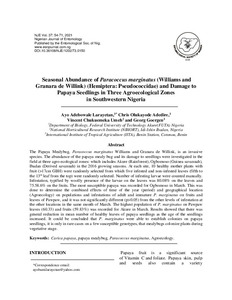| dc.contributor.author | Larayetan, A.A. |
| dc.contributor.author | Adedire, C.O. |
| dc.contributor.author | Umeh, V. |
| dc.contributor.author | Goergen, G. |
| dc.date.accessioned | 2024-01-09T14:28:11Z |
| dc.date.available | 2024-01-09T14:28:11Z |
| dc.date.issued | 2021 |
| dc.identifier.citation | Larayetan, A.A., Adedire, C.O., Umeh, V. & Goergen, G. (2021). Seasonal abundance of Paracoccus marginatus (Williams and Granara de Willink)(Hemiptera: Pseudococcidae) and damage to papaya seedlings in three agroecological zones in Southwestern Nigeria. Nigerian Journal of Entomology, 37, 54-71. |
| dc.identifier.issn | 0331-0094 |
| dc.identifier.uri | https://hdl.handle.net/20.500.12478/8371 |
| dc.description.abstract | The Papaya Mealybug, Paracoccus marginatus Williams and Granara de Willink, is an invasive species. The abundance of the papaya mealy bug and its damage to seedlings were investigated in the field at three agro-ecological zones: which includes Akure (Rainforest), Ogbomoso (Guinea savannah), Ibadan (Derived savannah) in the 2016 growing seasons. At each site, 10 healthy mother plants with fruit (> 17cm GBH) were randomly selected from which five infested and non-infested leaves (fifth to the 13th leaf from the top) were randomly selected. Number of infesting larvae were counted manually. Infestation, typified by woolly presence of the larvae on the leaves was 80.08% on the leaves and 75.58. 6% on the fruits. The most susceptible papaya was recorded for Ogbomoso in March. This was done to determine the combined effects of time of the year (period) and geographical location (Agroecology) on populations and infestations of adult and immature P. marginatus on fruits and leaves of Pawpaw, and it was not significantly different (p> 0.05) from the other levels of infestation at the other locations in the same month of March. The highest population of P. marginatus on Pawpaw leaves (60.33) and fruits (59.83%) was recorded for Akure in March. Results showed that there was general reduction in mean number of healthy leaves of papaya seedlings as the age of the seedlings increased. It could be concluded that P. marginatus were able to establish colonies on papaya seedlings, it is only in rare cases on a few susceptible genotypes, that mealybugs colonize plants during vegetative stage. |
| dc.format.extent | 54-71 |
| dc.language.iso | en |
| dc.subject | Carica Papaya |
| dc.subject | Mealybugs |
| dc.subject | Paracoccus Marginatus |
| dc.subject | Agroecology |
| dc.subject | Disease Control |
| dc.subject | Plant Health |
| dc.title | Seasonal abundance of Paracoccus marginatus (Williams and Granara de Willink) (Hemiptera: Pseudococcidae) and damage to papaya seedlings in three agroecological zones in Southwestern Nigeria |
| dc.type | Journal Article |
| cg.contributor.affiliation | Federal University of Technology Akure |
| cg.contributor.affiliation | National Horticultural Research Institute, Nigeria |
| cg.contributor.affiliation | International Institute of Tropical Agriculture |
| cg.coverage.region | Africa |
| cg.coverage.region | West Africa |
| cg.coverage.country | Nigeria |
| cg.coverage.hub | Headquarters and Western Africa Hub |
| cg.researchtheme | Plant Production and Health |
| cg.identifier.bibtexciteid | LARAYETAN:2021 |
| cg.authorship.types | CGIAR and developing country institute |
| cg.iitasubject | Agronomy |
| cg.iitasubject | Disease Control |
| cg.iitasubject | Food Security |
| cg.iitasubject | Plant Diseases |
| cg.iitasubject | Plant Health |
| cg.journal | Nigerian Journal of Entomology |
| cg.notes | Open Access Article |
| cg.accessibilitystatus | Open Access |
| cg.reviewstatus | Peer Review |
| cg.usagerightslicense | Creative Commons Attribution 4.0 (CC BY 0.0) |
| cg.targetaudience | Scientists |
| cg.identifier.doi | https://doi.org/10.36108/NJE/1202/73.0150 |
| cg.iitaauthor.identifier | Georg Goergen: 0000-0003-4496-0495 |
| cg.futureupdate.required | No |
| cg.identifier.volume | 37 |
| cg.contributor.acknowledgements | Sincere thanks to the National Horticultural Research Institute, Ibadan, for the technical and financial support. |

